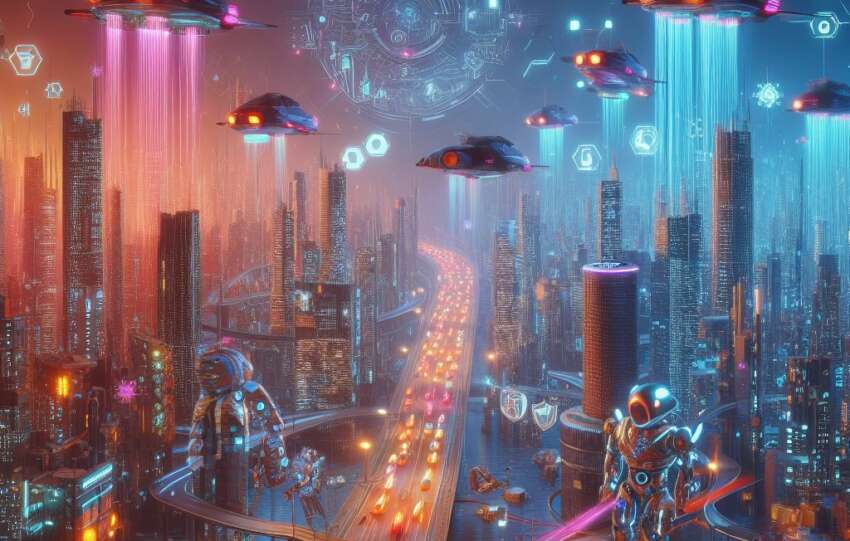Consider this: the human brain contains approximately 86 billion neurons, each forming about 10,000 synaptic connections to other neurons. This means there are over 100 trillion connections in your brain, all working in concert to produce thoughts, emotions, and conscious experiences. The complexity of these networks is staggering, and yet, we’ve only begun to understand the surface of how neural activities translate into conscious awareness.
Enter the hero of the story – mathematics.
There are over 100 trillion connections in your brain, all working in concert to produce thoughts, emotions, and conscious experiences.
Mathematics offers a beacon of hope in this dense fog of complexity. Through the use of mathematical models and theories, scientists are beginning to unravel how these myriad connections can produce the seamless experience of consciousness we all share. For instance, the Integrated Information Theory (IIT) of consciousness proposes that consciousness arises from the integration of information across various brain regions. This theory, deeply rooted in mathematical concepts, suggests that the more information a system has integrated, the higher its level of consciousness.
The million-dollar question? Whether math can be the key to unlocking the mysteries of our consciousness. Let’s take a look.
The Language of the Universe
Mathematics is like the secret code of the universe. It’s the language spoken by galaxies, the rhythm of nature, and the heartbeat of reality. And guess what? The brain might just be wired in the same numerical language. Neuroscientists are using math to crack the neural code, trying to decipher how the brain’s intricate network creates the symphony of consciousness.
Imagine your brain cells, or neurons, as the ultimate squad goals. They communicate through complex electrical signals, forming connections and firing off messages faster than you can say “E=mc².” Mathematicians are diving into this neural dance, crafting equations to understand the patterns that give rise to conscious experiences. Now, picture this: a dance floor packed with neurons, each moving to its mathematical beat. Researchers are using equations to map out the intricate choreography of neural connections. They’re discovering that specific mathematical patterns might be the key to unraveling consciousness.
Take synchronization, for example. When neurons sync up their firing, it creates a harmonious flow of information. Math helps us model and understand these synchronized dances, shedding light on how our brain creates the seamless experience of consciousness.
Fractals and the Mind’s Mandelbrot Set
Now, let’s get a bit trippy. Ever heard of fractals? These mind-bending shapes repeat themselves infinitely, creating complexity from simplicity. Each pattern, no matter how deeply you zoom in, reveals itself over and over again, ad infinitum. It’s as if you’re holding a mirror to another mirror, and the reflection goes on forever. Mathematicians like Benoît B. Mandelbrot showed us that the natural world is far from random but is instead intricately patterned. Mandelbrot’s work revealed that fractals are not just mathematical curiosities but the backbone of nature itself. From the delicate veins of a leaf to the majestic sweep of a mountain range, and even to the vast, spinning arms of galaxies, fractals are everywhere, suggesting a universal rule of self-similarity across scales.

AI-generated image of fractal Patterns in a Romanesco broccoli.
Guess what? Our brain might be no different. Some researchers speculate that the brain’s structure follows a fractal pattern, a kind of mind’s Mandelbrot set. By applying mathematical tools, scientists are delving into the fractal nature of the brain, exploring how these repeating patterns might be the fingerprints of consciousness. Understanding the fractal nature of the brain could revolutionize our approach to neurological disorders, mental health, and artificial intelligence. It posits that the key to unlocking the secrets of the mind and consciousness might lie in understanding how simple rules, repeated across scales, can generate the unfathomable complexity of the human experience.
The Quantum Conundrum
Now hold onto your hats because we’re taking a detour into the quantum realm. Quantum physics, the mind-boggling science of the very small, is throwing its hat into the ring when it comes to understanding consciousness. Some scientists propose that the brain operates on quantum principles, with particles existing in multiple states simultaneously. Mathematics plays a starring role in quantum mechanics, providing the tools to navigate this bizarre realm. Researchers are using mathematical equations to explore how quantum processes in the brain might be linked to consciousness. It’s like trying to solve a cosmic puzzle, and math is the guide leading us through the quantum conundrum.
Here’s where it gets really juicy – the Goldilocks zone of complexity. Just like Goldilocks searching for the perfect porridge, our brain operates in a sweet spot of complexity. It’s not too simple, nor too chaotic. Math helps us pinpoint this sweet spot, guiding researchers to understand the delicate balance that gives rise to consciousness. Think of it like this: too much order, and your brain might be as dull as dishwater; too much chaos, and it’s a wild rollercoaster without a seatbelt. Mathematicians are crafting equations that describe the optimal balance of complexity for consciousness – the Goldilocks principle of the mind.
The Holographic Brain
If you think we’re done with mind-bending concepts, think again. Welcome to the holographic brain theory, closely intertwined with the holonomic brain theory proposed by neuroscientist Karl Pribram in collaboration with physicist David Bohm. Some scientists propose that our entire conscious experience might be a holographic projection created by the brain, akin to Pribram’s suggestion that cognitive functions and perceptions arise from quantum processes and interference patterns, much like a hologram. In this mind-blowing convergence of ideas, every tiny piece of the brain contains information about the whole. Mathematics and quantum physics help us model and understand this complex interplay, serving as the foundational code. Equations and quantum principles reveal how the brain’s bits and pieces come together to create the seamless illusion of consciousness. It’s like living in a mathematical and quantum masterpiece, where every equation and quantum interaction paints a stroke on the canvas of our conscious experience.
Delving deeper into this integrated holographic and holonomic framework, we see a model where the brain’s quantum characteristics enable each fragment to potentially reflect the entirety of our conscious experience. This advanced perspective suggests that cognitive processes, such as perception and memory, are the result of quantum processes and interference patterns that span the entire neural network. Through this lens, the brain’s capacity to generate the cohesive reality we experience is akin to a hologram’s ability to project a complete image from each of its parts, grounded in the quantum and holographic principles. Mathematical equations and quantum mechanics serve as the code for these processes, unraveling the profound interconnectedness and the quantum underpinnings within our brains. This paradigm shift not only challenges conventional notions of neural localization but also highlights a complex, network-wide interaction of neural activities that crafts the rich tapestry of human consciousness, offering a quantum-informed insight into the holographic nature of our minds.
So, Can Math Crack the Code?
After this mind-expanding journey through the realms of neurons, fractals, quantum quirks, complexity, and holograms, the question remians: can mathematics truly crack the code of consciousness? The short answer: we’re getting closer, but it’s a puzzle with missing pieces. Math is the trusty guide, the compass leading us through the uncharted territory of the mind. Scientists are using equations to peel back the layers, revealing the mathematical underpinnings of consciousness.
But here’s the thing – consciousness might be the ultimate enigma, the cosmic riddle that keeps us on our toes. Math is our ally, helping us navigate the twists and turns, but there’s still a long road ahead. The quest to understand consciousness is like an epic adventure, and we’re just at the beginning of the journey. So let’s keep that spark of curiosity alive. Dive into the world of mathematics, explore the realms of the brain, and who knows – maybe you’ll be the one to crack the code of consciousness. The universe is waiting, and math is your ticket to unravelling its most mind-bending mysteries. Get ready for a ride that will leave you in awe, because the adventure has just begun!
____________
Written by: JK PANDEY




